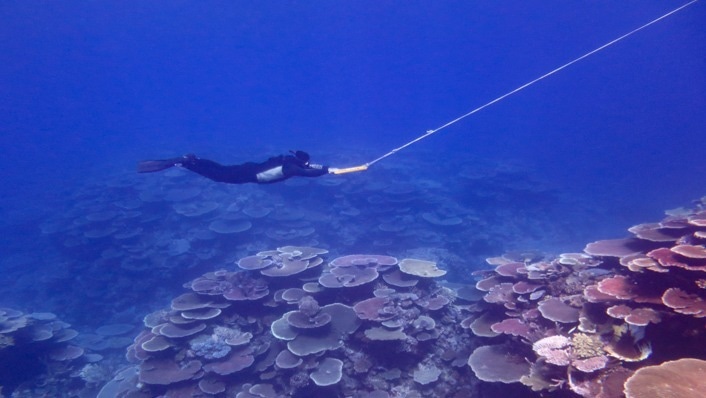Reviewed by Alex SmithAug 4 2022
Since the Australian Institute of Marine Science (AIMS) started monitoring the northern and central Great Barrier Reef 36 years ago, they have recorded their highest amount of coral cover.
 An AIMS Marine Ecologist Surveys a Reef Perimeter by Manta Tow on the Great Barrier Reef. Image Credit: Australian Institute of Marine Science.
An AIMS Marine Ecologist Surveys a Reef Perimeter by Manta Tow on the Great Barrier Reef. Image Credit: Australian Institute of Marine Science.
The coral cover on the Reef has grown again, according to AIMS’ Annual Summary Report on Coral Reef Condition for 2021/22.
Average hard coral cover increased to 33% (from 26% in 2021) in the Great Barrier Reef’s central zone and 27% in the region north of Cooktown between August 2021 and May 2022 as part of the AIMS Long-Term Monitoring Program (LTMP), which examined 87 representative reefs.
On the other hand, the average coral cover in the southern area (from Proserpine to Gladstone) fell from 38% in 2021 to 34%.
The loss of coral cover in the southern region, according to AIMS CEO Dr. Paul Hardisty, demonstrated how dynamic the Reef was, while the results in the north and center regions revealed that the Reef could still recover.
A third of the gain in coral cover we recorded in the south in 2020/21 was lost last year due to ongoing crown-of-thorns starfish outbreaks. This shows how vulnerable the Reef is to the continued acute and severe disturbances that are occurring more often, and are longer-lasting.
Dr. Paul Hardisty, CEO, Australian Institute of Marine Science
The rising frequency of large coral bleaching episodes, with this year’s event being the fourth in seven years and the first to take place during a La Niña, was “uncharted territory” for the Reef, according to Dr. Hardisty.
In our 36 years of monitoring the condition of the Great Barrier Reef we have not seen bleaching events so close together. Every summer the Reef is at risk of temperature stress, bleaching and potentially mortality and our understanding of how the ecosystem responds to that is still developing.
Dr. Paul Hardisty, CEO, Australian Institute of Marine Science
Dr. Hardisty adds, “The 2020 and 2022 bleaching events, while extensive, didn’t reach the intensity of the 2016 and 2017 events and, as a result, we have seen less mortality. These latest results demonstrate the Reef can still recover in periods free of intense disturbances.”
The team leader of the AIMS monitoring program, Dr. Mike Emslie, stated that the 2022 results built on the improvements in coral cover reported for 2021, with the majority of the increase still being driven by Acropora corals, which have a rapid rate of growth.
These corals are particularly vulnerable to wave damage, like that generated by strong winds and tropical cyclones. They are also highly susceptible to coral bleaching, when water temperatures reach elevated levels, and are the preferred prey for crown-of-thorns starfish. This means that large increases in hard coral cover can quickly be negated by disturbances on reefs where Acropora corals predominate.
Dr. Mike Emslie, Team Leader, AIMS Monitoring Program, Australian Institute of Marine Science
According to Dr. Emslie, climate change is causing maritime heatwaves to occur more frequently and last longer.
Dr. Emslie says, “The peak of the most recent bleaching event in March occurred when the accumulated heat stress caused widespread bleaching but not extensive mortality.”
“The increasing frequency of warming ocean temperatures and the extent of mass bleaching events highlights the critical threat climate change poses to all reefs, particularly while crown-of-thorns starfish outbreaks and tropical cyclones are also occurring. Future disturbance can reverse the observed recovery in a short amount of time,” explains Dr. Emslie.
Background
The largest, longest, and most thorough source of data on the condition of the Great Barrier Reef is the 36-year dataset of AIMS’ Long-Term Monitoring Program (LTMP). It aids in identifying long-term patterns in the state of coral communities throughout the Reef.
Percent hard coral cover describes the proportion of the reef that is covered in living hard coral. Most reefs surveyed in 2021–22 had between 10–50%.
Corals respond to stressful situations, including heat, by bleaching. The coral animal turns white and may even perish during bleaching as it loses its symbiotic algae and pigments. Corals are more stressed after a bleaching episode, but they can survive.
The Reef 2050 Integrated Monitoring and Reporting Program benefits from the LTMP.